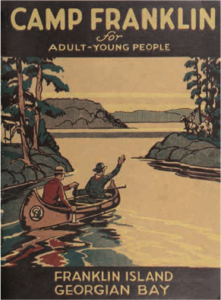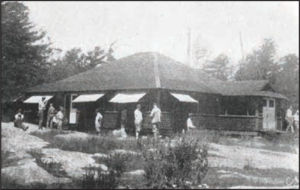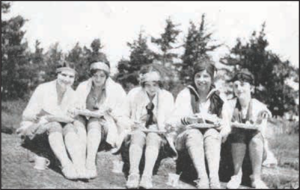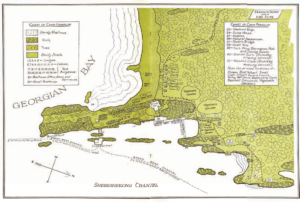By Allison Needham
In 1922, the Minwandum Camping Association established Camp Franklin, a youth camp located on the shores of Franklin Island where “goodwill, friendship, hearty laughter and unselfishness” were the main ideals of staff and campers.

Originally an all-boys camp under the direction of Reverend William J. Christie, it soon expanded to offer girls programming and coed camps for children and young adults. Family programs were also offered during busy seasons. The camp became so popular that camps in October and November were added with different themes and outdoor skills — one of which was learning to hunt. The camp operated each summer from June to October, until its close in 1937.
Billed as a getaway from the rush of the city, Camp Franklin was an opportunity to learn valuable outdoor skills while enjoying the fresh air. The staff encouraged the development of what became lifelong friendships and instilled a love and respect for the natural beauty that surrounded each visitor.
Activities included horseback riding, canoeing, swimming, various sports, rowing, sailing, nature study, fishing, photography, and much, much more. There were sports such as tennis, golf, volleyball,badminton, and baseball for all to compete in. In the evenings, campers could relax by the fire, participate in dances or masquerades, and even attend exclusive parties held on the grounds.
The 50-foot sailing yacht, Minwandum, offered campers the choice of a two, three, or four-day cruise to acquaint themselves with the 30,000 Islands. One of the most popular overnight trips was to Killarney where campers had the opportunity to photograph or paint the scenic views of the park.
Camp Franklin had five spacious lodges, four to 14 rooms each, with cozy living rooms, cheery fireplaces, and spacious verandahs, all picturesquely situated among the pines facing the Shebeshekong channel. The cabins and tent bungalows, dotted here and there, provided quiet and serene sleeping accommodations. As time went on, a dining and recreational hall, stables, and various types of courts for games, trails, laundry, vegetable gardens, a boathouse and a large wharf were added. The camp had its own post office, tuck shop, and medical attendant.

The Dining Hall
During its years of operation, the camp was a major employer and provided passengers to both railways and boat lines in the area. Many Carling residents worked on the island as cooks, dishwashers, instructors, guides, and cleaning staff.

“There is Health in every mouthful.”
With its natural beauty and adjacent provincial park, the island was the perfect setting for rest and outdoor activities. Walter C. Cain, Ontario Deputy Minister of Lands and Forests, wrote: “This island has many long, deep, narrow bays, which are the spawning beds of many kinds of fish, and numerous varieties of waterfowl haunt its shores. In addition, the island contains 11 small lakes most beautifully situated and surrounded by exceptionally well-wooded shores. These woods are the homes and nesting places of a wonderful variety of birds and the breeding ground of deer and other small game animals. Of the thirty thousand or more islands in the Georgian Bay, Franklin is described as the most attractive.”

Although it is all gone, those of us who have visited this magnificent island can still envision what Reverend Christie started. You can still find remnants of its past throughout the island, and Franklin remains a special place that draws people back, time and time again.